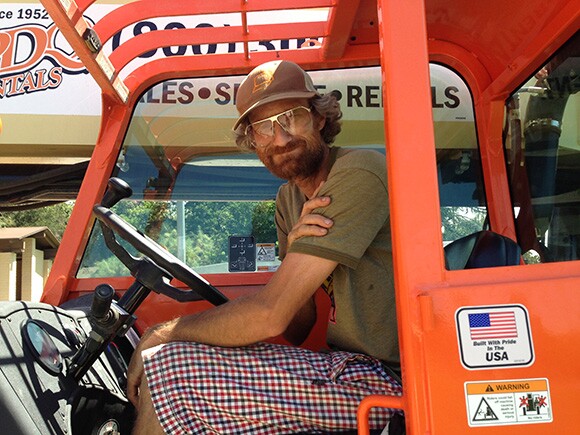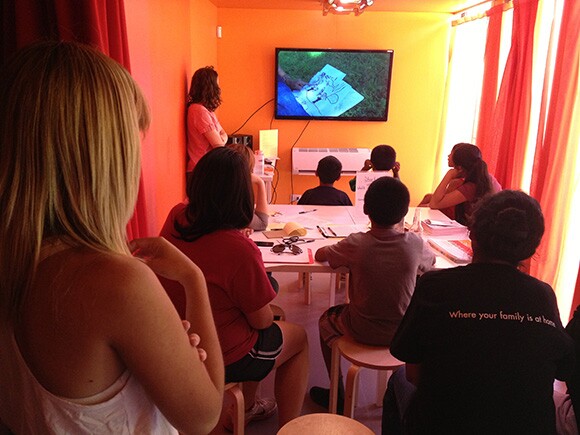Altadena Art + Film: A Travelogue from the LACMA9 Outpost

In partnership with LACMA9 Art + Film Lab, an in residence in nine communities, offers free art and film workshops, an oral history project, outdoor film screenings, plus a day of free admission to LACMA.
Driving north on Fair Oaks Avenue in Altadena, the galaxy of chain retailers and franchises that cluster around Colorado Boulevard slowly thin out and are replaced by family-owned businesses and modest mid-century houses. Whenever I drive this route from South Pasadena, I am struck not only by a visceral sense of transformation, but a surprising sense of relief. The bustle and anxious energy of the Old Town Pasadena shopping district are dampened by Altadena's noticeably slower pace and warm, lived-in quality. All around are obvious signs that this is a community where generations of families have built their lives and homes. By the time I reach the rocky foothills of the San Gabriel Mountains that enclose the town, I find myself feeling strangely soothed.
The neighborhood surrounding Charles White Park, where the LACMA9 Art +Film Lab has resided these past few weeks, is deceptively quiet during the day. Children in the park giggle and tease each other, and adults make conversation on the benches, but it is fairly calm. At least, that is, until just before sunset.
Distant sounds of a radio are broken by bursts of laughter as a birthday party commences nearby. A children's soccer team begins their practice. The shrill squawks and flapping wings of the feral parrots that patrol the San Gabriel Valley pass overhead. Bicycles and skateboards whizz and grind the sidewalks. I can hear hungry chickens clucking in someone's backyard, occasionally punctuated by the boisterous cock-a-doodle-doo of their attendant rooster. The shifting soundscape of the park and the neighborhood is fascinating and joyful. I listen closely as I begin my shift for the Lab and get ready for the evening's film screening.
On one of our first nights in Altadena, my co-worker and I stood in the middle of the park, unwrapping lengths of cable in preparation for the screening. I heard a faint, unexpected noise coming from somewhere in the neighborhood.
"Did you hear that?"
A pause, followed by a distinct bleating sound. My co-worker cocked his head and smiled slightly.
"I think someone around here has a goat."
As it grew dark, the park became louder, largely thanks to the Lab's doing. Our giant inflatable movie screen rose off the ground, accompanied by the droning white noise of the air compressor. Before nearly every screening, at least one child will approach me to ask if we are setting up a jumper or a "bouncy castle." There is a brief moment of disappointment on their faces when I tell them the truth, but it's immediately followed by genuine, wide-eyed excitement when I tell them it's a movie screen. It's always heartening to see those same kids come back for the film with their families and friends. It's especially heartening to see so many people show up to the screenings, despite the fact that the temperatures frequently drop into the 50s by the time the film begins. Audience members come prepared with heaps of blankets, hot drinks, and bags of snacks. Fridays seem to be the most popular night for screenings. Perhaps it's because it comes right on the heels of the workweek for most people, and everyone is eager to lose themselves for a little while, to fall under the spell of cinema.


Inside the Lab, there's more sound, but of a different nature. Before each screening, we facilitate oral histories. Each session attracts several participants -- some who have simply stumbled upon the lab while passing through the park, and others who traveled out of their way to visit us and record their story. In almost every case, I'm struck by the initial nervousness of the participants. I don't get the feeling that they're nervous because they're camera shy. It seems their nervousness stems from the anticipation of being listened to intently and closely. While we're all more or less comfortable with casual exchanges, I wonder if we have trouble accepting the idea that a stranger would want to truly listen to us and expect that we have interesting stories to tell. I frequently see people walk into an oral-history session feeling somewhat hesitant. After the session, they appear at ease, smiling and a little confident. Small, personal stories are so often lost that it's easy to forget their importance. These narratives bridge gaps in time -- in the grand scheme of history, they give context and detail to the large, sweeping events that feel so anonymous when future generations read about them in a textbook.
My co-workers who run the workshops tell similar stories. Students who, at first, seem intimidated by the idea of using a camera or a microphone to share a personal vision, suddenly gain a profound sense of creative freedom once they let themselves accept the idea that their stories are worth sharing. It is amazing to see adults allow themselves to play and recover a sense of childlike exploration.
As a practicing artist myself, these things all serve as potent reminders. It's easy to forget that indulging your sense of playfulness in the creative process is often the best strategy when you're working on a project. Pausing to listen to the world around you and allowing yourself to get lost in someone else's narrative are sometimes the most productive creative acts in which you can engage.
The Altadena Art+Film Lab would like to thank the amazing staff of our community partner, the Los Angeles County Parks and Recreation Department. Thanks go to: Albert Gomez, Alejandro Miranda, Aqueelah Williams, "Alex" Alejandra Robles, Charlena Brown, Daniel Gonzales, Geannies Butler, Kent Mardis, Kyle Sampson, Markus Carter, Martin Sanchez, Meliza Hernandez, Penny Daniels, and Sam Estrada. Additionally, we'd like to thank artist Ian White and Sandi "Mama" Romero of Mama's Hot Tamales.
Dig this story? Sign up for our newsletter to get unique arts & culture stories and videos from across Southern California in your inbox. Also, follow Artbound on Facebook and Twitter.